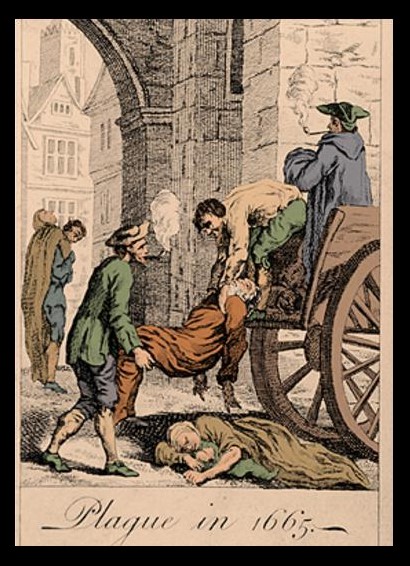Off to Hell in a hand cart, medieval style?
Introduction and a little history
![[Photo http://www.dailymail.co.uk/news/article-2521894/Bubonic-plague-outbreak-confirmed-Madagascan-village.html 11/122013]](https://freedomtoteach.collins.co.uk/wp-content/uploads/sites/87/2023/03/Plague-1.jpg)

The image above is one relating to Bubonic Plague, a disease that devastated much of Europe and Asia in the 14th century killing between 75 and 200 million people. Because of the appearance of victims’ skin it was known as “Black Death” and caused an estimated death rate of 30-60% of the population of Europe between 1346 and 1353. Caused by a bacterium, Yersinia pestis, it is likely that the disease originated in the plains of central Asia and travelled along with merchants on the Silk Road to the West carried by Oriental rat fleas which lived on Black rats. Black rats were common on merchant ships, so the inhabitants of ports quickly became infected and the disease was transmitted to the countryside by the indigenous rat and flea populations. It is likely that it took 150 years for the population of Europe to recover: the cost in human terms is difficult for us to imagine, the misery from the resulting economic ruin must have been another crushing blow. It is perhaps relevant to mention the Peasants’ Revolt in 1381 since post Black Death there were fewer men available to work the land and the economic balance tipped in favour of farm workers and away from their masters, thus civil insurrection in pursuit of improved conditions may have seemed a good gamble.
![Yersinia pestis (flourescent microscopy) [source: wikipedia]](https://freedomtoteach.collins.co.uk/wp-content/uploads/sites/87/2023/03/Plague-3-1.jpg)
The people of the time had no recourse to science for rational answers and sought solace in myth and association. Those with skin disorders caused by other diseases such as leprosy, acne and psoriasis were singled out and killed. Fanaticism flourished taking root as a persecution of identifiable groups; in August 1349, the Jewish communities of Mainz and Cologne were slaughtered.
Despite the disaster this disease caused to medieval Europe and Asia, it seems today to have disappeared from our concern. What was seen by our forebears as a dreaded manifestation of God’s wrath has been subjugated, relegated to a parable affecting a remote time and people.

But the principle has not changed; there is always a living to be had as a parasite, they are still there. Outbreaks of infection by Yersinia since medieval times have happened, notably in London in 1665 (see picture left), Sidney, Australia between 1900 and 1925 and as recently as 2013 in Madagascar. These were outbreaks, not a pandemic because we now understand how we can alter the rules of infection to favour ourselves. However, it is a chill reminder that DNA sequence of Yersinia in the outbreak Madagascar in 2013 is almost identical to that extracted from skeletons of those dying in London in the 14th century.
There is debate concerning the reasons for the end of the Black Death pandemics. Authors offer various explanations; probably they all had a combined effect. With reduced human populations there was less opportunity for the vector to carry the disease to uninfected people, reduced travel and household quarantine would also make contagion less likely. It seems that, possibly as a result of the experience of the “pestilence”, personal hygiene also improved which will have reduced the flea population and the burning of corpses in mass funeral pyres will also have removed infected fleas. Acquired immunity is a possibility through surviving an immunologically challenging dose of the pathogen’s antigen but insufficient virions to kill, or passive immunity through antibodies received, for example from already exposed mothers. Lastly, selection must have been pretty thorough so that only those with the genetic make-up to survive will have been around to pass on their genes
The effect on the artists of the time was profound, a recurring theme being “The Dance of Death”, where the universal claim of death no matter what your station is celebrated. For examples of this genre see:
http://en.wikipedia.org/wiki/Danse_Macabre#mediaviewer/File:Thetriumphofdeath.jpg
(Painting by Pieter Brueghel the elder, engravings by Hans Holbein and others.)
http://lucerne.all-about-switzerland.info/lucerne-spreuerbridge-dance-death.html
(Interesting paintings in the triangulum below the roof of the Spreuer Bridge)
Well, that’s about it for this blog. I have included some of the usual fun activities for you to be getting on with and the usual nod towards the role of this work in satisfying sections in various syllabuses. Next time, as I mentioned previously, we shall exclusively concentrate on the virus causing Ebola.
John Giles
John Giles is an educational consultant and author specialising in IT and computing. He works closely with exam boards, and has written syllabuses and exam papers.
Some questions and activities you might like
Try longer answers (or arguments, as appropriate) to these:
- Make “must have” list for a promising super star disease organism
- Take sides in the argument that actual “disease” is necessary in your list
- Make another list of reasons why infectious diseases will eventually end
- Take sides in the argument that medical treatment is possibly good for the individual but possibly bad for the species
Reading around the subject
My major sources for this blog have been:
- http://en.wikipedia.org/wiki/Black_Death
- http://en.wikipedia.org/wiki/Plague_%28disease%29
Naturally there is a limit on space and I have missed out much of the articles and reading them yourself would be interesting for you
Another source is interesting, particularly relating to the contagion of Ebola:
- http://www.nhs.uk/conditions/ebola-virus/pages/ebola-virus.aspx
The rabbit disease Myxomatosis has been used to reduce the naturally occurring rabbit populations of several countries. Originally the death rate was around 95% but two factors have changed. Firstly genetic selection has resulted in a higher proportion of the rabbits being resistant to the disease and secondly, the virus has itself changed to become less aggressive. The former is easily explained and to be expected, but the explanation for the virus becoming less pathogenic is interesting. I’m not spoon-feeding you! Read the article:
http://en.wikipedia.org/wiki/Myxomatosis
Now you should see why it should be that selection works to mitigate the virulence of the virus. Can you speculate on other diseases which might benefit (to the disease causing organism that is) from this effect? Is this true for all diseases caused by pathogenic organisms, are there exceptions?
Some examples of syllabus content for which the above exercises are relevant:



